Achieving perfect soap trace requires careful temperature control. Keep your oils and lye solution between 120-130°F, with no more than a 10-degree difference between them. Avoid cold lye that solidifies oils or excessive heat that accelerates trace too quickly. Use water discounting (1:1 water-to-lye ratio) for better control. Consider the heat transfer method for simplified melting. Monitor room temperature, insulate appropriately, and adjust techniques seasonally. Master these temperature principles and your soap making success will multiply exponentially.
7 Essential Temperature Controls For Perfect Soap Trace
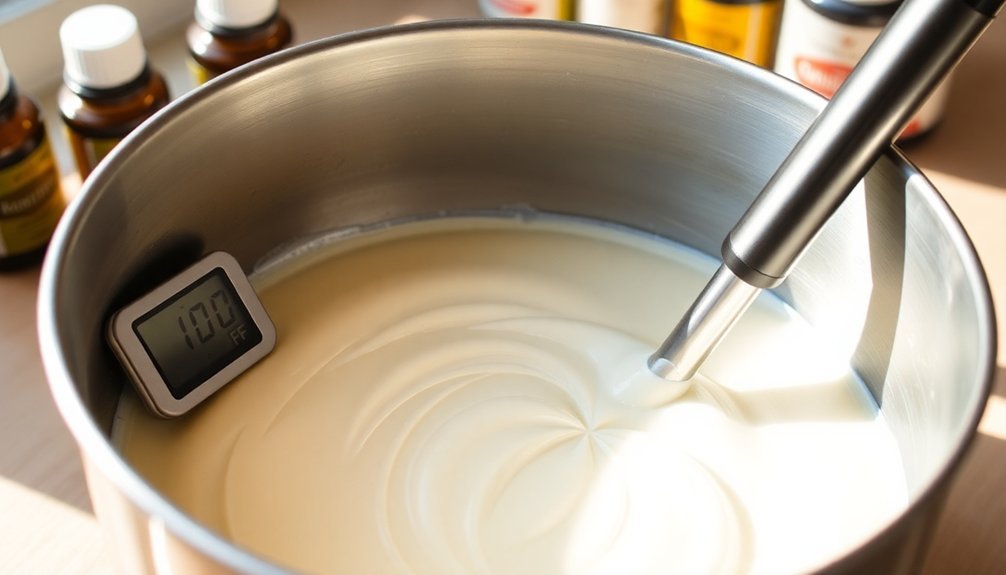
While many soapmakers develop their own unique methods, maintaining proper temperatures remains non-negotiable for achieving perfect trace. During cold process soap making, keep both oils and lye within 120-130°F to guarantee proper emulsification and prevent false trace.
Your oils should appear clear, not cloudy, which indicates solidified fatty acids that can disrupt the saponification process.
Cool your lye solution adequately before combining with oils—too cold and it'll solidify your oils; too hot and it'll accelerate trace uncontrollably.
Consider implementing a water discount with a 1:1 water-to-lye ratio to better control trace speed. For efficiency, utilize the heat transfer method by pouring hot lye solution over solid oils with higher melting points, letting the natural heat do the work before blending.
These temperature controls will consistently deliver predictable, manageable trace in your soap batches.
Understanding How Temperature Affects Soap Trace Stages
Because temperature acts as the primary catalyst in soap chemistry, understanding its impact on trace stages gives you precise control over your soap-making process.
During cold process soap making, the 120-130°F range creates ideal conditions for proper emulsification between your oils and lye solution.
- High temperatures accelerate saponification, resulting in faster trace development – useful when you need quick setup but potentially limiting design time.
- Low temperatures risk false trace, where oils appear thick but haven't truly emulsified – this can lead to separation issues later.
- Temperature differential between lye and oils should stay within 10 degrees to prevent solidified fats that disrupt proper saponification.
Your water-to-lye ratio further influences trace behavior, with lower ratios helping maintain better control over the consistency of your soap batter.
The Ideal Temperature Range for Cold Process Soap Making
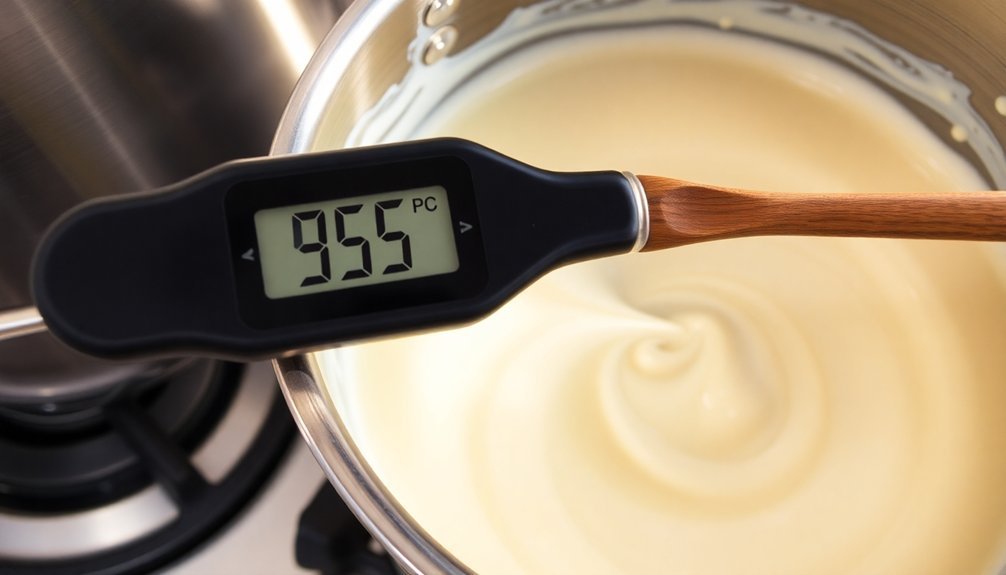
Finding the perfect temperature balance represents one of the most essential elements for successful cold process soap making.
The ideal temperature range for both oils and lye solution falls between 120-130°F, creating ideal conditions for proper emulsification and saponification.
You'll want to keep your lye temperatures within 10 degrees of your soap making oils to prevent complications.
Always verify your oils appear clear without cloudiness, as cloudy oils indicate solidified fatty acids that can disrupt the process.
Lower temperatures below 100°F often lead to false trace, where your mixture appears thick but hasn't properly emulsified.
Conversely, higher temperatures accelerate the reaction, potentially causing defects in your final soap bars.
For best results, cool your lye solution to around body temperature before combining it with your oils.
Preventing False Trace by Mastering Oil Temperatures
False trace represents one of the most frustrating challenges soap makers encounter when oil temperatures aren't properly managed.
To create proper emulsification, you'll need to maintain your oils between 120-130°F and guarantee they're completely melted with no cloudiness. This temperature control prevents solidified fatty acids that create a grainy soap batter.
For best saponification and prevention of false trace:
- Prepare your lye solution at body temperature (98.6°F) and allow it to cool to 120-130°F
- Keep your oils and lye solution within 10 degrees of each other for smooth blending
- Consider using the heat transfer method, where hot lye solution melts your oils to achieve ideal soaping temperature
These temperature controls create the perfect environment for true trace development without the disappointment of premature thickening.
Lye Solution Temperature Management for Consistent Results
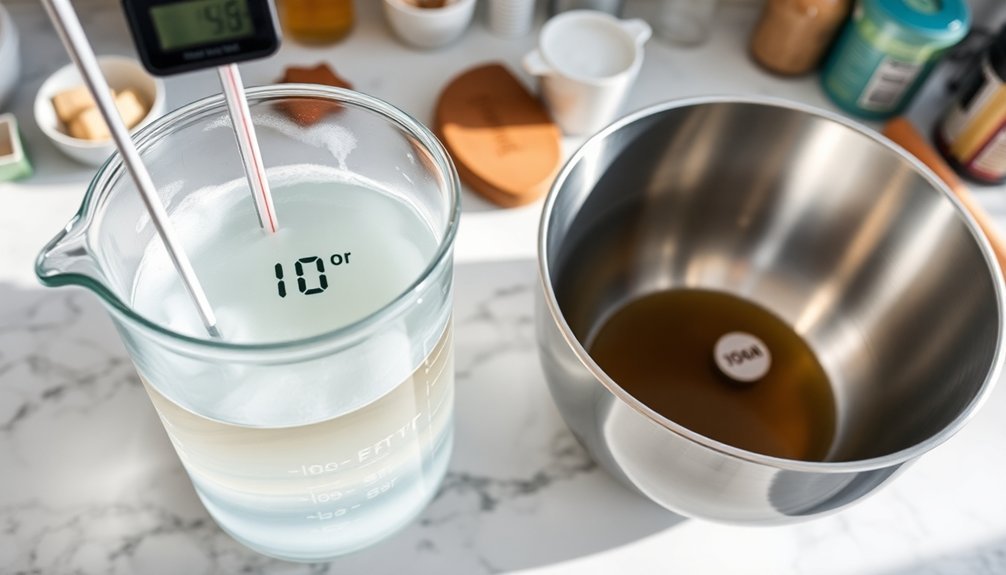
You'll need to cool your freshly mixed lye solution to 120-130°F before combining it with your oils to avoid accelerating trace too quickly.
Timing your lye preparation 1-3 hours ahead of soaping allows natural cooling to the perfect temperature range while preventing the crystallization that can occur with overly cool solutions.
Monitoring the heat transfer between your lye solution and oils guarantees they remain within 10 degrees of each other, creating ideal conditions for controlled, predictable trace development.
Lye Cooling Guidelines
When making soap, your lye solution temperature plays a critical role in achieving consistent trace results. The exothermic chemical reaction can heat your solution up to 200°F, far too hot for proper saponification.
Cooling your lye solution to 120-130°F before combining with oils guarantees ideal emulsification and prevents false trace issues.
- Allow your lye solution to cool for 1-3 hours before soap making to reach the ideal temperature range.
- Maintain your lye solution within 10 degrees of your oil temperature to promote smooth mixing and even saponification.
- Avoid using lye that's too cold, as it can solidify oils upon contact, compromising soap quality and emulsification.
Proper temperature management during cooling creates the foundation for successful trace development and consistent soap quality in every batch.
Monitor Heat Transfer
Successful soap-making hinges on properly managing the heat transfer between your lye solution and oils. Keep your lye solution temperature between 120-130°F to guarantee oils remain fully melted and homogenized when combined, preventing false trace issues.
After the initial exothermic reaction causes temperatures to spike (sometimes above 200°F), allow your lye solution to cool to the recommended range before mixing with oils. This controlled cooling enhances saponification without causing oils to solidify upon contact.
When utilizing the heat transfer method, you're leveraging the lye solution's warmth to melt your oils – particularly effective with soft and liquid varieties. For consistent results, monitor both components to guarantee they're within 10 degrees of each other.
These temperature controls help you achieve predictable trace and prevent unwanted early thickening in your soap batter.
Heat Transfer Method: Utilizing Temperature Differences to Your Advantage
While traditional soap making often requires separate heating of oils and lye solutions, the Heat Transfer Method offers an elegant alternative that maximizes efficiency.
This technique leverages the heat generated by your hot lye solution to naturally melt your oils, creating a perfectly balanced soap mixture while maintaining ideal temperature control.
To properly execute this method:
- Weigh your oils directly into your mixing container before adding the hot lye solution.
- Maintain both components between 120-130°F to prevent false trace and guarantee proper saponification.
- Consider the melting points of your chosen oils, as softer oils respond better to this technique.
This approach works particularly well with liquid oils, eliminating the need for external heat sources and simplifying your soap making process while still achieving professional results.
Room Temperature Considerations for Successful Soap Batches
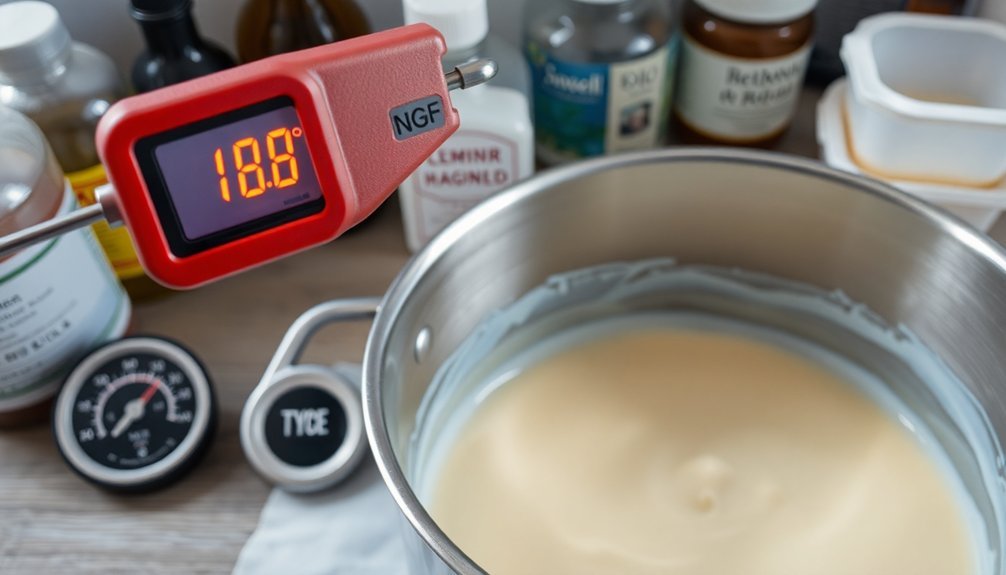
The ambient temperature of your soap making environment plays an essential role in determining the quality and consistency of your final product. Aim to maintain your workspace between 70-80°F to guarantee liquid oils remain fully melted and prevent false trace during your process.
Cooler environments can cause oils to solidify prematurely, resulting in grainy soap batter that's difficult to emulsify properly.
Conversely, high room temperatures can accelerate trace development, especially when working with coconut oil and other fast-tracing ingredients.
When adding essential oils that generate heat, monitor your surroundings closely to maintain suitable conditions.
Consider using insulation techniques or heating pads to manage temperature fluctuations, which will support a successful gel phase and enhance the vibrancy of your colorants.
Frequently Asked Questions
What Temperature Is a Soap Trace?
Soap trace typically occurs when your mixture reaches 120-130°F. You'll want to keep your lye and oils within 10 degrees of each other to achieve proper saponification and avoid false trace issues.
What Is the Best Temperature for Saponification?
The best temperature for saponification is 120-130°F. You'll want to maintain both your oils and lye solution within this range to guarantee proper chemical reactions, prevent false trace, and achieve smooth, successful soap making results.
How to Make Soap Trace Faster?
You can make soap trace faster by using high-saturated oils like coconut, warming oils to 130°F, adding trace accelerators like sugar, reducing water content, and using your stick blender in short bursts while mixing.
What Temperature Should Soap Be Poured At?
You should pour your soap at 120-130°F for both oils and lye. Keep them within 10 degrees of each other for proper emulsification. Don't go below 100°F or above 160°F to avoid defects.
In Summary
Temperature control is your secret weapon for consistently perfect soap trace. By monitoring your oils, lye solution, and workspace temperatures, you'll avoid common pitfalls like false trace and accelerated saponification. Remember, it's not just about following recipes—it's about understanding how temperature affects your soap's development. Master these seven temperature controls and you'll transform your soaping experience from unpredictable to reliably successful every time.
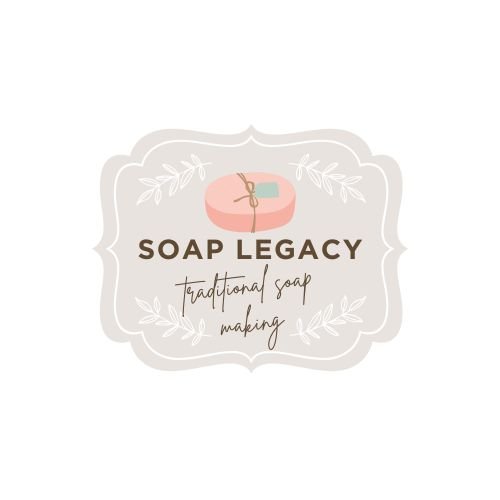
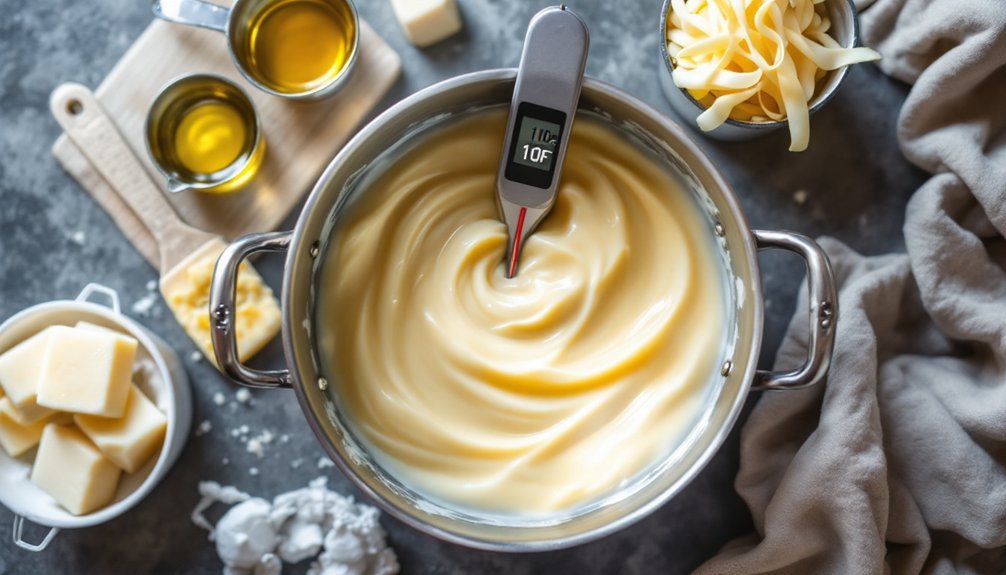
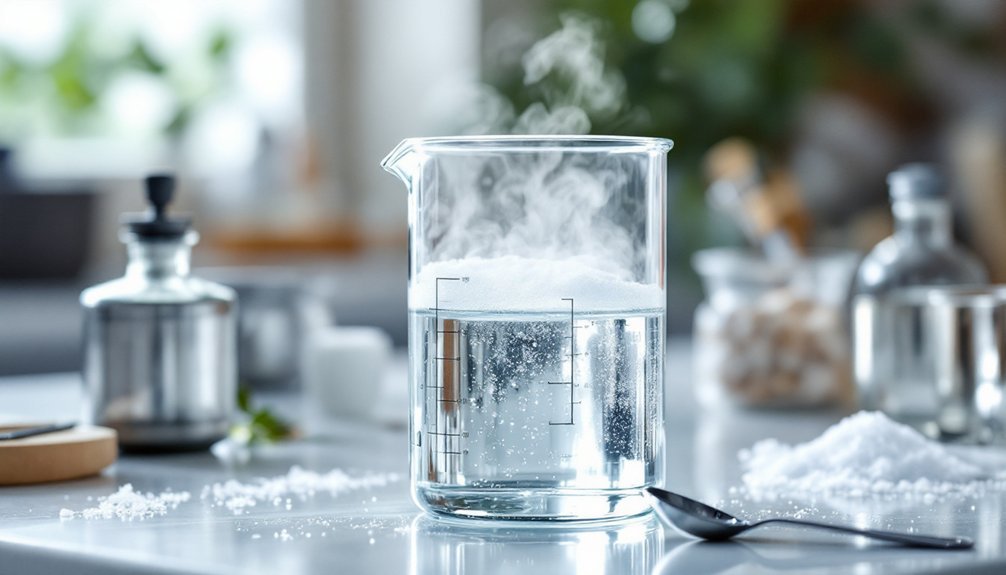
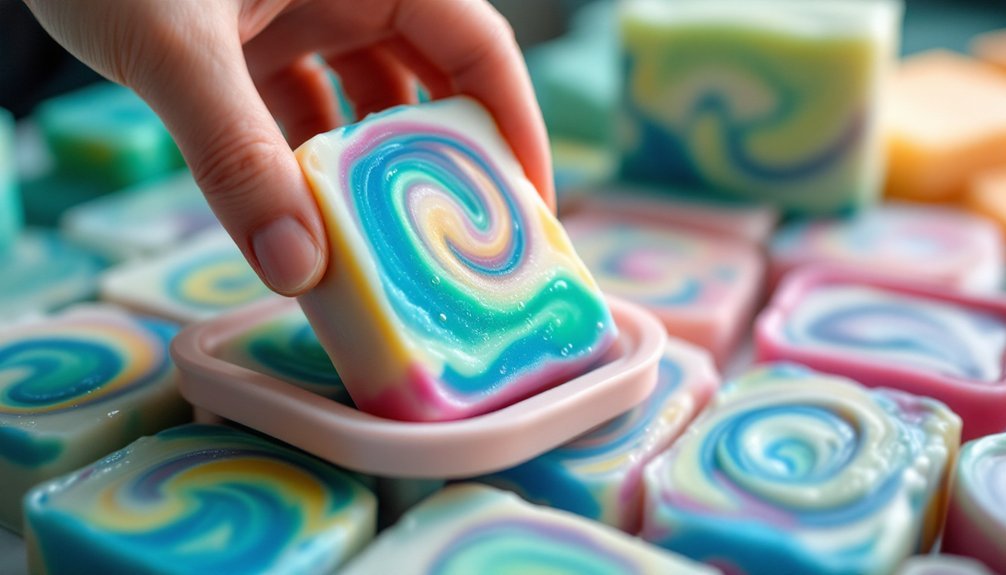
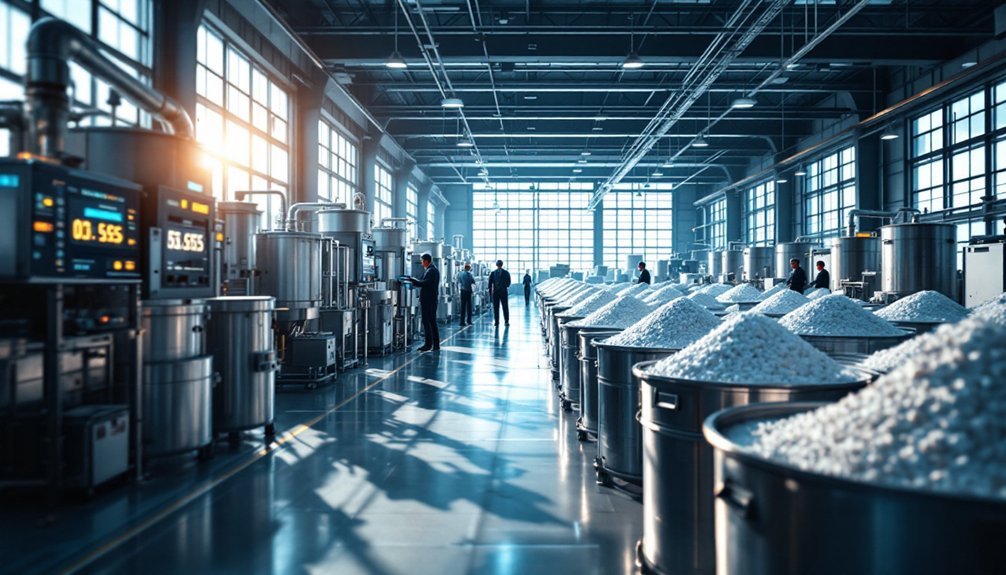
Leave a Reply